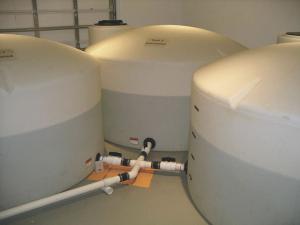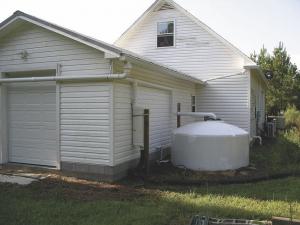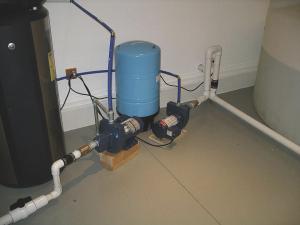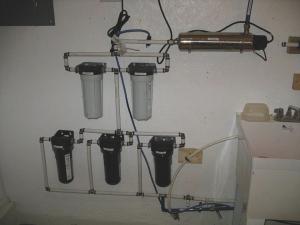Rainwater Storage Tanks Eliminated Need For Well
Mike Minga’s system to collect rainwater for drinking and regular household use is a big step up from other systems we’ve seen for watering gardens and yards. When he built his home, he included a 24 by 25-ft. room to hold four 1,100-gal. tanks and the necessary pumps and filters to provide water to the home. Another 1,100-gal. tank outside collects water from rain gutters fitted with microscreen filters and a first-flush diverter to take out debris before going into the tank.
Minga created the system for about half the cost of drilling a new well. He explains that there was a well when he purchased the property, but the water was brown, creamy and smelled because it had so much iron. Well drillers around White Oak, N.C., said they could drill another well for about $8,000, but they couldn’t guarantee the water would be any better.
“At our previous home I had experimented with collecting water off our roof in an 1,100-gal. tank to use for the toilet and washing machine, and it cut our water bill in half,” Minga says.
He had also seen rain water systems while traveling in the Caribbean and Bermuda, and he found plans on a Bermuda website. He obtained information and equipment such as a UV sterilizer and micron filters at www.rainharvest.com. Searching for “cistern design for water harvesting” brings up many good websites, he says.
Minga painted the outside tank black to keep out sunlight, which grows algae, then painted it white again so it wouldn’t heat up with the sun. Water is pumped from that settling tank into one of three tanks inside. The utility room with the tanks is completely finished off and has a garage door and painted windows to prevent sunlight from entering and growing algae in those tanks.
“The tanks came from a farm supply store,” Minga says. “They are often used by winemakers.”
The fourth tank holds the “treated” water. The treatment includes pumping the water from one of the other tanks through three .5-micron filters, then two .2-micron filters and finally a UV sterilizer at the rate of 7 to 8 gal./minute. From there it’s hooked up to a pump and pressure tank delivering water to the home’s plumbing.
One tank holds enough water for 2 1/2 to 3 weeks for the two-person household. Once a week, Minga checks the water level. When it’s low he turns on the UV sterilizer, which needs a few minutes to start up, then turns on the pump. It takes an hour or two to fill the tank, and he adds a little chlorine. Minga could add floats and timers to automate the system, but says he doesn’t mind the weekly chore.
Minga notes that at first they were frugal with water usage and only drank water after it went through the refrigerator filter. But after testing the water and finding out hard metals were negligible even though the roof is asphalt, he realized the water was pure enough to drink from the tap. There is also plenty of water for normal usage – even washing the car.
Once a year, he cleans the tanks by removing water with a wet-vac, then scrubbing them with bleach water.
North Carolina gets plenty of rain, and water is usually available year round. As a backup plan if there is a drought, Minga says he would pay the fire department to haul water that he would run through his treatment system.
“The real key to make this work is to be sure to calculate the water you use and the amount of water you get on your roof,” Minga says, noting there are calculators on various websites.
Besides saving money drilling the well, the only additional electricity used is to pump water into the treated tank. Plus, Minga says, he doesn’t need a water softener.
“The water is very soft. And when we wash a car, we don’t have to dry it off,” he says.
Contact: FARM SHOW Followup, Mike Minga, 8746 Tabor Church Rd., White Oak, N.C. 28399 (ph 910 486-0085; mingamichael@gmail.com).

Click here to download page story appeared in.
Rainwater Storage Tanks Eliminated Need For Well FARM HOME Miscellaneous Mike Minga’s system to collect rainwater for drinking and regular household use is a big step up from other systems we’ve seen for watering gardens and yards When he built his home he included a 24 by 25-ft room to hold four 1 100-gal tanks and the necessary pumps and filters to provide water to the home Another 1 100-gal tank outside collects water from rain gutters fitted with microscreen filters and a first-flush diverter to take out debris before going into the tank Minga created the system for about half the cost of drilling a new well He explains that there was a well when he purchased the property but the water was brown creamy and smelled because it had so much iron Well drillers around White Oak N C said they could drill another well for about $8 000 but they couldn’t guarantee the water would be any better “At our previous home I had experimented with collecting water off our roof in an 1 100-gal tank to use for the toilet and washing machine and it cut our water bill in half ” Minga says He had also seen rain water systems while traveling in the Caribbean and Bermuda and he found plans on a Bermuda website He obtained information and equipment such as a UV sterilizer and micron filters at www rainharvest com Searching for “cistern design for water harvesting” brings up many good websites he says Minga painted the outside tank black to keep out sunlight which grows algae then painted it white again so it wouldn’t heat up with the sun Water is pumped from that settling tank into one of three tanks inside The utility room with the tanks is completely finished off and has a garage door and painted windows to prevent sunlight from entering and growing algae in those tanks “The tanks came from a farm supply store ” Minga says “They are often used by winemakers ” The fourth tank holds the “treated” water The treatment includes pumping the water from one of the other tanks through three 5-micron filters then two 2-micron filters and finally a UV sterilizer at the rate of 7 to 8 gal /minute From there it’s hooked up to a pump and pressure tank delivering water to the home’s plumbing One tank holds enough water for 2 1/2 to 3 weeks for the two-person household Once a week Minga checks the water level When it’s low he turns on the UV sterilizer which needs a few minutes to start up then turns on the pump It takes an hour or two to fill the tank and he adds a little chlorine Minga could add floats and timers to automate the system but says he doesn’t mind the weekly chore Minga notes that at first they were frugal with water usage and only drank water after it went through the refrigerator filter But after testing the water and finding out hard metals were negligible even though the roof is asphalt he realized the water was pure enough to drink from the tap There is also plenty of water for normal usage – even washing the car Once a year he cleans the tanks by removing water with a wet-vac then scrubbing them with bleach water North Carolina gets plenty of rain and water is usually available year round As a backup plan if there is a drought Minga says he would pay the fire department to haul water that he would run through his treatment system “The real key to make this work is to be sure to calculate the water you use and the amount of water you get on your roof ” Minga says noting there are calculators on various websites Besides saving money drilling the well the only additional electricity used is to pump water into the treated tank Plus Minga says he doesn’t need a water softener “The water is very soft And when we wash a car we don’t have to dry it off ” he says Contact: FARM SHOW Followup Mike Minga 8746 Tabor Church Rd White Oak N C 28399 ph 910 486-0085; mingamichael@gmail com
To read the rest of this story, download this issue below or click
here to register with your account number.









